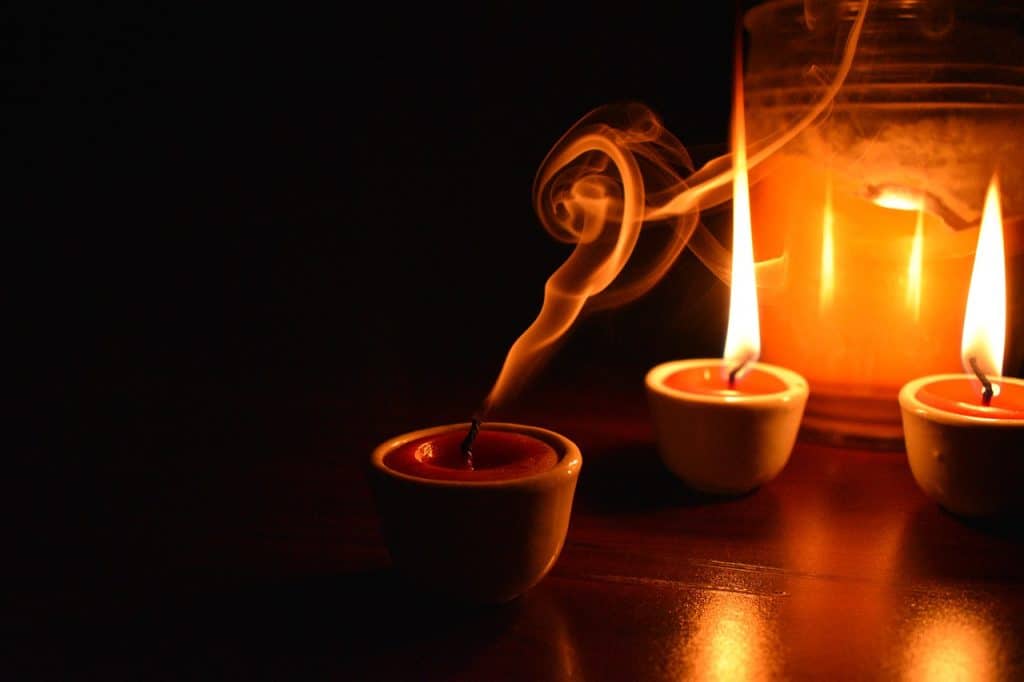Burning a candle at home is a common way to reduce stress and to bring ambiance to the home. Scented candles can add a lovely and welcoming aroma, while unscented can change the feel of a room or a meal, as well as a back up for any power outages or other occurrences. There are risks to burning candles though, often the risk is that of fire, but the smoke from these candles can also be dangerous to the health of lungs and the respiratory system. Particularly found with scented candles, the smoke caused by the burning wick and melting wax includes many particles and chemicals that can cause damages, but this risk is small when a candle is burnt infrequently in a well lit area. While inhaling large amounts will cause irritation and even damages to the lungs, throat, and may affect the oxygen levels, the slight smoke presented by one candle is not likely to be enough for lasting damages.
If you inhale slight smoke from a candle there may be a slight irritation, it can happen very quickly, in the eyes, the nose, and the throat.
If you inhaled the candle smoke your steps should be:
- Move quickly away from the candle, and if possible, extinguish it with a candle snuffer or even blow it out as necessary.
- As the smoke will continue to accumulate until the flame has been extinguished, so having it out quickly will greatly reduce the amount of smoke that is inhaled over time, but there will be a brief increase in smoke as it dies out and stops.
- This smoke that comes upon the extinguishing may also be stronger, so it is necessary to not be directly in the path of it whenever possible.
Coughing may occur from inhaling candle smoke, and upon its occurrence it is important to move away from the source of the smoke. Where many candles are burning it is often best to simply go outside and leave a window to clear the smoke from the room. A glass of water or lozenge may help to reduce the coughing and the irritation in the throat, but an irritation within the lungs will not be as easily solved.
Eyes that become irritated by the smoke can be helped by a damp cloth across the eyes. This will sooth the irritation and restrict any further smoke from affecting the eyes. This same damp cloth can be used to cover the nose and mouth, to filter any further smoke from entering the respiratory system and from affecting the inside of the nose or the mouth. This will ease the irritation of the nose and throat as well. Cool water may be more soothing then warm, and a light cloth should be used to allow air flow to continue, while distance is placed between the person and the candle.
When there has been an increased or ongoing amount of candle smoke inhaled it can create ongoing and lasting problems for the entire health of the body. The chemicals that are used to create the candles and the scents will build up in the space and can create a build up within the body as well. In some instances there is metal within the wick of the candle which adds another source of fumes and chemicals that are breathed in upon burning and melting of the candle. These chemicals can lead to asthma, cancer, and allergies among other concerns. To avoid ongoing medical concerns the time spent near burning candles should be limited and inhaling the smoke directly should be avoided.
When one has been around excess candle smoke and there are symptoms present treatment should be sought by a doctor. The treatments that are provided for overexposure and illness are important and differ from the treatments to long term affects. Where the breathing and respiratory system has been affected there can be oxygen treatments that will help to return the skin to its natural color where a blue tinge has occurred, or in the event of carbon monoxide a red hue may appear on the skin. An oxygen tent may be sued, or a hyperbolic chamber where the lack of oxygen has been extended or strong, and there may be additional treatments at home. A puffer or inhaler may be provided for continued use at home whether for a period of treatment and recovery or ongoing for asthma and other lasting effects. When headache occurs, fresh air should be sought and treatment can begin, both for the symptom of a headache but also for the cause of the headache, be it chemical compounds that are released from the burning candle or if it is from decreased oxygen due to direct inhalation.
There may be an increased sound that accompanies breathing directly after inhalation, a rattle or a wheeze either from the nose or from the respiratory system. This is often caused by the inflammation of the throat and airways and can be treated by medical professionals to reduce the swelling and free the airways to be open and receive the oxygen needed.
Where these symptoms are present there may also be chest pains developed and should be treated immediately. Chest pains can occur due to coughing, reduced oxygen flow to the heart from limited breathing, and any irritations through the respiratory track can cause pain in the heart and the lungs. If these symptoms occur there has been a large amount of smoke inhaled and there is need for immediate treatment. Other symptoms to watch for are confusion, trouble breathing or shortness of breath, shallow and quick breathing, and changes to skin color and voice becoming hoarse and damaged.
While immediate treatment for smoke inhalation is unlikely during safe and well ventilated use of a candle, there are other risks as well. The particles that are sent into the air through the burning of the wick and the melting of the wax, and these chemicals are multiplied by the addition of a scent into the wax or a metal included in the wick itself. These chemical particles are very small and can travel deep into the respiratory track making them not only a concern for the moment of burning but also can build up within the body and cause long term affects over time. While immediate symptoms may be present during direct inhalation there may be other slower effects that are noticed over time, such as increased illness and respiratory concerns, formation or worsening of asthma and COPD, and allergies that are hard to control and may not be connected to other activities. These can affect life in many ways, ruling out sports and exercise by limiting the oxygen intake, and may require ongoing treatments to maintain a regular lifestyle.
The lasting affects of the candle smoke are dependent on what the candle is made of and what is contained within the wick. A soy or beeswax candle will have different effects then a paraffin wax candle will. A paraffin candle has many chemical components that will burn into fine and small particles which are breathed deep into the lungs and through the entire respiratory system affecting all the areas as it passes. A beeswax will have fewer chemicals and is safer for use within the home, particularly if there is to be steady or frequent use. Before using any candle in the home, and especially before using several of them for any length of time or a few frequently, it is important to read the labels and discovery what ingredients are included. One that has fewer irritating chemicals is safer for the health of the people in the home, and any pets as well. Though every candle will have smoke, and this will enter the lungs and the body in some amount, the ones that are more naturally occurring and with chemicals that are least damaging to the body are the best choice for frequent use.
The risk of damage from breathing candle smoke should not keep their use from the home all the time, to indulge in the view and environment created by candlelight once in a while is safe. One should avoid being directly within the smoke from the flame, and candles chosen should be those with the fewest chemical compounds, as those will be released as the candle is lit and for a short time after it is put out. Beeswax and soy have been discovered to be a safer option then the paraffin candles, and those with scent added will have more particles and compounds released then others, increasing the risk of allergies, asthma, and other ongoing health concerns. If you should inhale a slight amount of candle smoke simply remove yourself from the space and step away from the candle, when possible have it put out to stop the smoke from accumulating. If coughing, wheezing, and other slight concerns arrive they can be treated at home, but where coughing is extreme, breathing is hampered, color of the skin is changing or being tinted blue or has a red hue, or confusion occurs treatment from a medical professional should be sought as quickly as possible.




